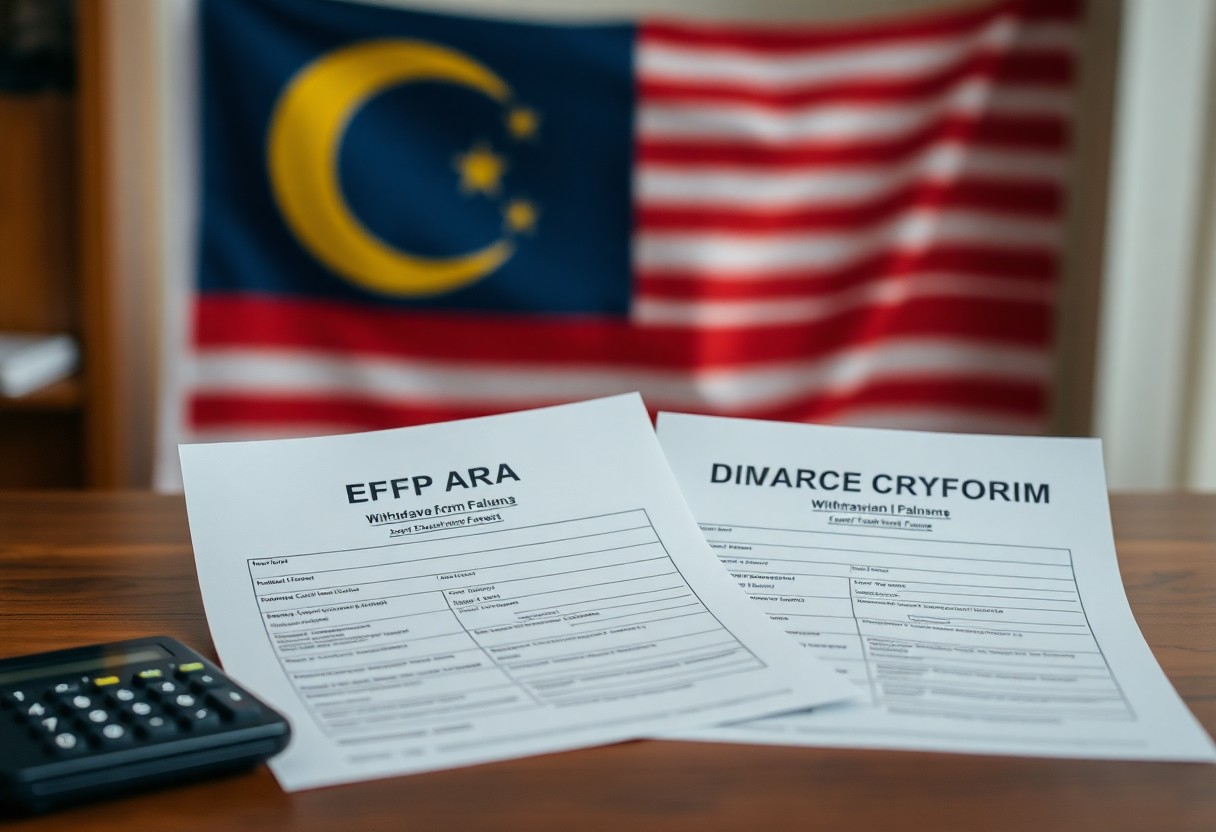Over the course of your life, navigating a divorce can be a challenging experience, particularly when it comes to understanding EPF withdrawal rules in Malaysia. If you find yourself in this situation, it’s important to be aware that you may be entitled to withdraw your Employee Provident Fund (EPF)
Navigating the Emotional Landscape of Divorce
Your emotions may feel like a tumultuous sea as you deal with the aftermath of divorce. Many experience feelings of grief, anger, and even relief. Research indicates that it can take an average of one to three years to fully adjust to life post-divorce. Engaging in supportive networks, whether from friends, family, or professional counselors, can greatly ease this transition. Some find journaling or joining support groups helpful to process their experiences. Each individual’s journey is unique, but acknowledging your feelings and allowing yourself the time to heal is imperative in moving towards a healthier future.

Key Takeaways:
- EPF withdrawal for divorce is permitted under the Employees Provident Fund Act, allowing members to access their savings in certain situations.
- Eligible members must provide valid documents such as a divorce certificate or court order when applying for EPF withdrawal due to divorce.
- There are specific conditions regarding the amount that can be withdrawn, generally allowing members to access their savings from the account that has the most contributions.
- The application process involves submitting the required documents through the EPF’s official channels, either online or at designated branches.
- Members can only make one withdrawal for the purpose of divorce, which emphasizes the need for thorough financial planning.
- EPF also provides support and guidance on the implications of divorce on retirement savings, encouraging members to fully understand their financial situation.
- Consultation with legal and financial advisors is recommended before proceeding with EPF withdrawal to ensure compliance with all regulations and to assess the long-term impact on retirement funds.
Key Takeaways:
- EPF (Employees Provident Fund) savings can be withdrawn by members upon divorce under specific conditions.
- Members must provide a certified copy of the divorce decree or settlement agreement to facilitate the withdrawal process.
- The withdrawal can only be made from the member’s share of the EPF savings, not from the spouse’s account.
- It is advisable to consult with legal and financial professionals to navigate the EPF withdrawal rules following a divorce.
- Withdrawal applications can be submitted at EPF offices or through the EPF online portal, depending on eligibility.
- There may be tax implications on the amounts withdrawn, thus understanding tax responsibilities is vital.
- Post-divorce, it is beneficial to reassess financial goals and retirement plans to ensure long-term stability.

The Legal Framework of Divorce in Malaysia
Your understanding of divorce in Malaysia is anchored in a complex legal framework comprising various laws that govern both civil and Islamic divorces. The primary legislations include the Law Reform (Marriage and Divorce) Act 1976 for non-Muslims and the Islamic Family Law Enactment for Muslims. Each set of laws offers distinct procedures and requirements, influencing how you may navigate the divorce process depending on your religious affiliation.
Key Legal Provisions Governing Divorce
Key legal provisions guiding divorce in Malaysia detail the grounds for divorce, including irretrievable breakdown of marriage, and outline the procedural steps for filing a divorce petition, such as the necessary documentation and attendance at court hearings. In civil cases, you must file your application in the appropriate court while fulfilling the stipulated financial obligations, whereas in Islamic contexts, proceedings align with the rules of the Syariah Court.
The Role of the Syariah Court vs. Civil Court
The Syariah Court primarily handles cases involving Muslims, focusing on Islamic principles, while the Civil Court addresses the divorce matters of non-Muslims. Each court operates under its jurisdiction, influencing how your divorce proceedings unfold. In your situation, the choice of court will significantly affect the legal processes, the grounds for divorce you can cite, and the support claims you may pursue.
Understanding the role of the Syariah Court as compared to the Civil Court is vital for navigating divorce in Malaysia. The Syariah Court exclusively serves Muslim couples, applying Shariah laws and providing a more tailored approach to family disputes. This means that if you are Muslim, your divorce will likely involve stages like ruju’ (reconciliation attempts) and talak (unilateral divorce), which are not present in the Civil Court processes. On the other hand, if you’re a non-Muslim, the Civil Court will guide you through a more straightforward legal framework based on the Law Reform (Marriage and Divorce) Act, emphasizing equitable distribution of assets and responsibilities. Ultimately, your choice of court can significantly impact the outcome of your divorce, including asset division and custody arrangements.
The Role of EPF in Financial Security
The EPF plays a vital role in ensuring financial security for Malaysians, especially during significant life transitions such as divorce. By accumulating savings over the years, the EPF provides a safety net that can support you in addressing immediate financial needs. Following divorce, leveraging these funds can significantly ease the burdens of legal fees, housing, and other vital expenses, helping you rebuild your financial foundation.
Understanding Employee Provident Fund Fundamentals
The Employee Provident Fund (EPF) is a government-mandated retirement savings scheme designed to secure your financial future. Contributions are made by both you and your employer, accumulating interest over time to provide a robust financial cushion upon retirement or in periods of financial difficulty, such as divorce. Knowing how your EPF works can empower you to make informed financial decisions.
How EPF Functions as a Lifeline in Divorce
Your EPF can serve as a vital resource during divorce proceedings. In times of emotional stress and financial instability, accessing your EPF savings may relieve both immediate and long-term monetary pressures. Specifically, you may withdraw a portion or the entirety of your contributions, which can then assist in covering expenses like legal costs or securing new housing.
In many cases, the financial landscape can feel overwhelming after a divorce, making EPF withdrawals a lifeline for those in need. For example, if you previously relied on dual incomes, navigating single-parent responsibilities or living on a single paycheck can amplify existing financial strains. Utilizing your EPF funds may provide the breathing room necessary to cover immediate costs such as mortgage payments, childcare, or divorce settlements. This option ensures that you can focus more on rebuilding your personal and professional life without the shadow of financial burdens looming overhead.

EPF Withdrawal Mechanism During Divorce
The EPF withdrawal mechanism allows individuals to access their funds, which can provide significant financial relief during a divorce. Procedures are in place to facilitate access while ensuring compliance with regulations. You must submit the necessary documentation to initiate the process and may need to provide evidence of your divorce proceedings. Be aware of the timelines and requirements to ensure a smooth transaction for your needs.
Eligibility Criteria for EPF Withdrawals
To qualify for EPF withdrawals due to divorce, you must meet specific eligibility criteria. Primarily, you need to furnish proof of divorce proceedings, such as a court order or divorce certificate. Additionally, you must be a contributing member of the EPF and have a sufficient balance to facilitate the withdrawal. This information helps determine your right to access your funds during this challenging phase.
| Criteria | Details |
|---|---|
| Divorce Documentation | Proof of divorce, such as a court order or certificate |
| Membership Status | Active EPF member with regular contributions |
| Withdrawal Amount | Minimum balance must be met for withdrawal |
| Application Submission | Submit the application with required documents |
| Processing Time | Allow time for processing after submission |
Types of Withdrawals Available
EPF offers various types of withdrawals during divorce, each designed to meet specific needs. These include partial and full withdrawals, which can be taken from your accumulated contributions. The partial withdrawal typically allows you to access a percentage of your savings, while a full withdrawal expends the entire account balance. Understanding the right option for your situation can help you effectively manage your finances during and after the divorce.
| Withdrawal Type | Description |
|---|---|
| Partial Withdrawal | Access up to a specified percentage of your savings |
| Full Withdrawal | Utilize the entire EPF balance available to you |
| Withdrawal for Legal Fees | Covers expenses directly associated with the divorce |
| Housing Loan Settlement | Used to settle outstanding housing loans |
| Personal Financial Assistance | Helps with immediate financial needs during transition |
- Partial Withdrawal allows you to manage your financial capacity without exhausting your account. This can serve as immediate support while planning your next steps.
- Full Withdrawal provides access to your entire savings but requires careful consideration of future financial stability; hence, it’s often advisable to evaluate your long-term needs.
- Withdrawal for Legal Fees simplifies covering potential costs associated with court proceedings, ensuring you don’t face financial strain during a sensitive time.
- Housing Loan Settlement options can help you maintain stability in housing arrangements, aiding you in establishing independence after the divorce.
- Personal Financial Assistance can be crucial during this period, allowing you to focus on moving forward instead of immediate financial pressures.
This overview illustrates the different types of withdrawals available from the EPF during the divorce process, enabling you to choose wisely according to your circumstances. Understanding the fund’s offerings can empower you to take control of your financial journey during a divorce.
Withdrawal Conditions and Eligibility Criteria
To be eligible for EPF withdrawal due to divorce, you must meet specific conditions set by the Employees Provident Fund Act. You can only withdraw your savings if your divorce is finalized through official legal proceedings, ensuring that the separation is legitimate and recognized by law. Additionally, both you and your ex-spouse must be EPF members, as withdrawals can only be made from accounts belonging to the parties involved in the divorce.
Specific Legal Grounds for EPF Withdrawal During Divorce
Legal grounds for EPF withdrawal during divorce include the completion of divorce proceedings or court orders that require the division of assets. You must provide proof of your marital status and the finalization of the divorce through necessary legal documentation. In some cases, the court may direct the withdrawal to facilitate fair distribution of assets between both parties.
Required Documentation and Procedures
To proceed with the EPF withdrawal, you need to prepare specific documents to support your application. These typically include your divorce certificate, a copy of your NRIC, and an application form provided by the EPF.
Gathering the required documentation is vital for a smooth withdrawal process. The divorce certificate serves as proof of your marital status, which the EPF needs for verification. Additionally, you will need to fill out the EPF Withdrawal Form 13D and submit it along with a copy of your identity card. Once your application is submitted, the EPF typically processes it within 30 days, provided all documents are in order. Ensuring that everything is completed accurately can help avoid delays and complications during your EPF withdrawal.
The Financial Implications of EPF Withdrawals
Withdrawing from your EPF account during a divorce can provide immediate financial support, yet it often comes with significant long-term drawbacks. The decision to access these funds should be weighed against the potential loss of future retirement savings. You might alleviate some current expenses, but this can result in inadequate funds when you reach retirement age, making it imperative to consider how this withdrawal affects your overall financial picture.
Short-term Financial Relief vs. Long-term Impact
Accessing your EPF can feel like a lifeline amid the upheaval of divorce, offering short-term relief for urgent financial needs. However, this action may deplete your retirement savings and hinder your long-term financial stability. You could find yourself facing a difficult balance as immediate relief contrasts with the potential for increased financial insecurity later in life, particularly if you are not able to replenish those funds.
Assessing Asset Division and Future Security
Your decision regarding EPF withdrawals must consider the broader context of asset division. The impact on your future financial security is profound, especially if your EPF contributions formed a significant portion of your overall assets. You should carefully evaluate how this decision aligns with the division of other marital assets, as it can influence your overall financial health for years to come.
Evaluating asset division is key in strategizing for your future security. Suppose you withdraw funds from your EPF account. In that case, this amount should be factored into your overall asset pool during divorce negotiations. Suppose your spouse is entitled to a portion of your EPF savings. In that case, withdrawing funds can affect their share, potentially leading to disputes that could disrupt the asset division equity. Ensure you carefully weigh these dynamics to protect your long-term financial stability while navigating through this challenging period.

Potential Financial Implications of Withdrawal
Withdrawing your EPF savings during a divorce can lead to significant financial repercussions. Accessing these funds may provide immediate relief for pressing expenses like legal fees or housing, but it may also reduce your long-term financial stability. Consider that this money could have grown through compounded interest, and tapping into it now can compromise your retirement security or future investment opportunities.
Short-term Gains vs. Long-term Consequences
While the ability to withdraw EPF funds might help you tackle short-term financial needs, the long-term consequences could outweigh these immediate benefits. For instance, using your EPF to pay off debts or cover living expenses may alleviate financial pressure now, yet it diminishes your future financial safety net. Assessing the balance between your current obligations and future needs is important in order to maintain your overall financial health.
Tax Considerations Around EPF Withdrawals
When withdrawing EPF funds, you might face various tax implications that could affect your financial situation. Although the actual EPF withdrawal itself is generally non-taxable, any income earned from these funds can be subject to tax, depending on how you choose to utilize them post-withdrawal. Furthermore, understanding how your overall income changes due to a withdrawal can impact your tax bracket and respective obligations.
The taxation around EPF withdrawals can be complex. While you won’t incur taxes on the principal amount, if you withdraw the funds and invest them, the returns generated from those investments may be subject to income tax. Suppose you choose to keep the funds in a high-yield savings account or invest in bonds or stocks; the income you earn could eventually count towards total taxable income. Always consult with a tax advisor to navigate the implications and ensure you maximize your financial outcomes while adhering to government regulations.

Navigating Emotional and Psychological Aspects
Going through a divorce often takes a toll on your emotional and psychological state. The multitude of changes and uncertainties that accompany the dissolution of a marriage can lead to feelings of distress and loneliness. It is vital to acknowledge these feelings instead of suppressing them. The emotional strain can distract you from making sound financial decisions, potentially complicating your EPF withdrawal process. Prioritizing your mental health during this time is imperative; seeking guidance and fostering connections with supportive individuals can ease the journey ahead.
The Impact of Financial Decisions on Mental Well-being
Your financial choices in the wake of a divorce can significantly affect your mental well-being. Utilizing your EPF savings may alleviate immediate monetary concerns, but it can also foster anxiety about long-term security. Balancing short-term relief with the potential for future complications needs careful consideration. Recognizing the connection between financial stress and mental health can empower you to make decisions that prioritize both your finances and your emotional stability.
Support Systems and Resources Available
Establishing a solid support system during a divorce can make a world of difference. Numerous resources are available, including counseling services, support groups, and financial advisors specializing in divorce. Engaging with professionals and connecting with others who have undergone similar experiences can provide valuable insights and encouragement. Moreover, many organizations in Malaysia offer workshops and resources specifically designed for individuals navigating divorce, ensuring you are not alone in this challenging time.
Access to support systems can be transformative. Consider reaching out to local NGOs, counseling centers, or even community-based support groups that focus on divorce-related issues. These organizations often provide not just emotional support but also can facilitate workshops covering various aspects of post-divorce life, including financial planning and stress management. Furthermore, confiding in trusted friends or family can also prove invaluable; their insights and experiences may help you gain clarity and confidence in your decisions. Taking advantage of these resources is a significant step towards processing your emotions and creating a stable foundation for your future.
Strategies for Managing Post-Divorce Finances
Post-divorce financial management requires a strategic approach to ensure stability and growth. You need to assess your new financial situation comprehensively, which may involve evaluating assets, income, expenses, and future financial goals. Developing a clear plan that incorporates immediate needs, long-term objectives, and potential investments can help you navigate this new chapter effectively. Supplementing your income through part-time work or pursuing educational opportunities for career advancement can further bolster your financial position.
Budgeting for Independence After Divorce
Creating a budget becomes crucial for regaining your financial independence after a divorce. Start by listing all sources of income and monthly expenses, including necessities like housing, transportation, and food. Prioritize savings for emergencies and retirement, while ensuring that you don’t overspend in the transition period. Tracking your expenditures with budget-tracking apps can help you stay on course and adjust as needed, ultimately leading to a more secure financial future.
Rebuilding Retirement Savings: Steps to Recovery
Rebuilding your retirement savings post-divorce involves a strategic approach. Begin by reviewing your EPF balance and determining how withdrawing funds may have impacted your long-term security. Contribute a portion of your income to your EPF account whenever possible, taking advantage of employer contributions to maximize growth. Consider diversifying investments into other retirement accounts or financial instruments that align with your risk tolerance and future goals.
To successfully recover your retirement savings, you may want to explore employer-matching contributions offered in new job opportunities, which can significantly enhance your savings potential. Setting a specific savings goal, such as allocating 10-15% of your monthly income to retirement, can provide clarity and purpose. Additionally, engaging with a financial advisor can offer personalized strategies to optimize investment options, track growth, and adapt your plan as life circumstances evolve. This proactive approach is crucial for ensuring a comfortable retirement and mitigating the impacts of divorce on your financial stability.

Expert Insights: Common Misconceptions and Advice
Myths About EPF Withdrawals and Divorce
Many individuals believe that EPF withdrawals during a divorce are straightforward and can be initiated without consequences. However, misconceptions abound; for example, some think you can withdraw any amount without considering contribution limits or that your spouse cannot claim a portion of your EPF savings. In reality, the EPF Act stipulates specific rules governing withdrawals to ensure that both parties are fairly treated during asset division.
Professional Guidance for Effective Decision-Making
Engaging a financial advisor or lawyer experienced in divorce proceedings can significantly impact your decision-making. These professionals can provide a tailored analysis of your financial situation, helping you navigate the complexities of EPF withdrawals. They’ll ensure that your choices align with your long-term financial goals while safeguarding your legal rights during the divorce process.
When seeking professional guidance, it’s beneficial to understand your financial standing and set clear objectives. Experienced advisors can help interpret the EPF regulations you may not fully grasp and outline the potential implications of withdrawing your funds. With their expertise, you can make informed choices that safeguard your assets while addressing immediate financial needs stemming from the divorce. By knowing your options and leveraging professional advice, you enhance your position as you navigate this life-altering transition.
Expert Insights and Real-Life Experiences
Perspectives from Family Law Practitioners
Family law practitioners emphasize the importance of understanding the nuances of EPF withdrawal in the context of divorce. Many point out that while legal entitlements are clear, emotional factors often complicate proceedings. With cases like split asset settlements and custody arrangements, having a knowledgeable lawyer can significantly mitigate stress and ensure that your interests are well-represented, allowing for a smoother transition during this challenging time.
Testimonials from Individuals who’ve Navigated EPF Withdrawal
Individuals who have navigated EPF withdrawal during and post-divorce often share enlightening experiences. One participant, a divorced mother of two, recalled how her EPF funds helped secure housing and stability after her marriage ended. Another individual mentioned feeling overwhelmed by the paperwork but found that collaborating with a financial advisor made the process much more manageable and less daunting.
Many testimonials highlight practicality in the face of personal upheaval. A survey of recent divorcees revealed that over 65% successfully accessed their EPF funds, with most indicating it provided necessary financial support during their transition. Experiences vary, yet common themes emerge: streamlined communication with the EPF board and the necessity of documenting all claims. These personal stories illustrate not only the financial implications but also the emotional uplift that comes from regaining control over your finances in the aftermath of a divorce.
Final Words
To wrap up, understanding the divorce and EPF withdrawal rules in Malaysia is necessary for you as it directly impacts your financial future post-divorce. By familiarizing yourself with the procedures and requirements related to the Employees Provident Fund, you can make informed decisions regarding your savings and investments. Be sure to keep all necessary documentation handy, and consider consulting with a financial advisor or legal professional to navigate this process smoothly and ensure that you secure your financial well-being during and after your separation.
Conclusion
Presently, understanding the rules regarding EPF withdrawal during a divorce in Malaysia can significantly impact your financial stability. You should be aware that eligibility for withdrawal is granted under specific conditions, allowing you to access your funds to support your transition. It is vital to gather necessary documentation and follow the correct procedures to ensure a smooth process. By staying informed and following the guidelines, you can make informed decisions regarding your EPF savings during this challenging time.
FAQ
Q: What are the eligibility criteria for EPF withdrawal during a divorce in Malaysia?
A: In Malaysia, a member of the Employees Provident Fund (EPF) can apply to withdraw their savings in the event of a divorce. The eligibility criteria include being a member of the EPF and having a divorce decree issued by a Malaysian court. The EPF also requires proof of marriage, such as a marriage certificate, and documentation related to the divorce proceedings.
Q: How can I apply for EPF withdrawal after my divorce?
A: To apply for an EPF withdrawal after a divorce, you need to complete the EPF withdrawal form, which can be obtained from the EPF website or any EPF branch. You will also need to submit supporting documents, including the divorce decree, marriage certificate, and your identification card. Once the application is completed, it can be submitted at the nearest EPF branch or via their online services.
Q: Is there a specific amount I can withdraw from my EPF fund upon divorce?
A: The amount you can withdraw from your EPF account following a divorce depends on the balance in your account and the specific EPF withdrawal rules. Generally, you can withdraw either the total amount in your Account 1, or a portion of the balance from both Account 1 and Account 2, subject to EPF regulations. It’s advisable to verify your account balance and consult the EPF guidelines for precise amounts.
Q: Are there any tax implications when withdrawing EPF funds due to divorce?
A: In Malaysia, withdrawals from the EPF are typically not subject to income tax, including withdrawals due to divorce. However, it is advisable to consult with a tax professional or refer to the latest EPF guidelines for any updates or changes regarding tax implications on withdrawals.
Q: Can I withdraw my EPF savings if I have a custody arrangement for children after divorce?
A: Yes, if you have a custody arrangement that requires financial support for your children, you may be eligible to withdraw your EPF savings. You would need to provide relevant documentation, such as the custody agreement and proof of child support, along with your EPF withdrawal application.
Q: What happens to the EPF fund if both spouses want to claim it after a divorce?
A: In cases where both spouses are entitled to claim EPF funds post-divorce, the EPF will require both parties to provide documentation regarding the divorce settlement. The fund will typically be split according to the agreement made during divorce proceedings or as decided by a court order, provided that both parties have submitted the necessary documentation to support their claims.
Q: How long does it take for the EPF withdrawal process to be completed after filing?
A: The processing time for EPF withdrawal applications can vary, but typically it can take anywhere from a few weeks to a couple of months. Factors that may influence the processing time include the completeness of the submitted documents and the volume of applications being processed by EPF. To avoid delays, ensure that all required documents are accurate and complete when submitting your application.
